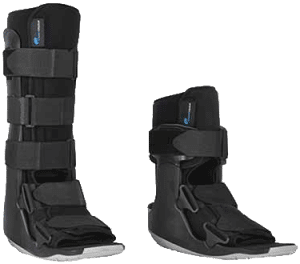Peroneal Tendonitis Treatment
The main function of the peroneal tendons is to stabilize the foot and ankle and protect them from inversion sprains. The tendons work to evert or prontate the foot.
Injuries most commonly occur after an ankle sprain. Also, individuals who participate in sports that involve repetitive side to side motion are at a higher risk for peroneal tendonitis. Most commonly seen in tennis, volleyball, hiking, basketball, soccer, zumba class. In addition, people with higher arches, pes cavus are at risk for developing peroneal tendon injuries.
Subluxation of the peroneal tendons occurs when one or both tendons have slipped out of their normal position behind the fibula. In some cases, subluxation is due to a condition in which a person is born with a variation in the shape of the bone or muscle. In other cases, subluxation occurs following trauma, such as an ankle sprain. Surgery is typically done to prevent the tendons from subluxing if conservative treatments fail.
Symptoms of Peroneal Tendonitis
A snapping or clicking feeling of the tendon around the ankle bone.
Pain behind the outside ankle bone.
Pain along the lateral part of the leg.
Ankle instability, weakness, and frequent sprains.
Pain at the base of the 5th metatarsal.
Pain at the lateral cuboid bone.
Diagnosis of Peroneal Tendonitis
A detailed history and physical exam with muscle and tendon evaluation is very important.
Imaging studies such as an MRI may be needed to fully evaluate the extent of peroneal tendon injury or tendon tear.
Treatment of Peroneal Tendonitis
Rest, ice, compression, and elevation is the first line of treatment.
A walking boot is helpful after the initial injury.
Physical therapy should start very quickly after pain and edema subside.
The videos below go over a peroneal tendon strengthening techniques.
An orthotic made with a rearfoot valgus post can sometimes help.
Using a Theraband and an exercise board will help in recovery.
Wearing an ankle brace can help limit symptoms.
Surgery for Peroneal Tendonitis
If pain continues, surgery is an option.
Dr. Kolodenker performs surgery on injured or torn peroneal tendons.
Peroneal Tendon Surgery should focus on repair of any degenerative tendon or tears within the tendon.
The bad part of the tendon is cut out and the torn areas are sutured together.
Early range of motion is critical. Physical Therapy will speed up recovery.
For a surgical consult, please contact Dr. Gennady Kolodenker, DPM, AACFAS in Orange County Huntington Beach or Irvine, California (949)651-1202
Disclaimer
These videos are for information only. The contents of the videos, such as graphics, images, text, quoted information and all other materials (“Content”) are provided for reference only, do not claim to be complete or exhaustive or to be applicable to any particular individual’s medical condition. Viewers should always consult with a qualified and licensed physician or other medical care provider. Users are warned to follow the advice of their physicians without delay regardless of anything seen or read in these videos. OC Podiatry assumes no duty to correct or update the Content nor to resolve or clarify any inconsistent information that may be a part of the Content. Reliance on any Content is solely at the User’s risk. The videos may contain health or medically related materials considered sexually explicit. Users are warned that if they may be offended by such Content, an alternate source of information should be found. Publication of information or reference in videos to specific sources such as specific products, procedures, physicians, treatments, or diagnoses are for information only and are not endorsements.
Last Updated 11-02-2016





